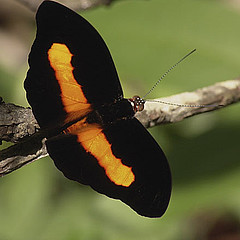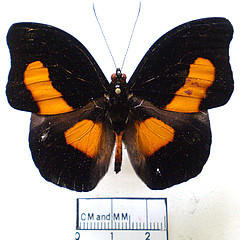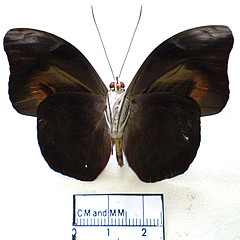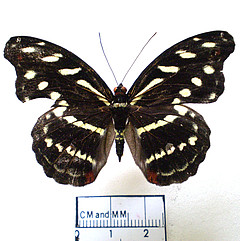Catonephele acontius (Linnaeus, 1771)
Acontius Banner
Papilio antiochus (Fabricius, 1775) (Papilio), repl. name; preocc. (not Linnaeus, 1767)
Papilio medea (Fabricius, 1775)
Papilio chione (Cramer, 1776)
Papilio eupalemon (Cramer, 1777)
Catonephele eupalemaena Hübner, [1819]
Catonephele acontius exquisitus Stichel, 1899
Male and female are commonly caught in fruit traps, both in the understory and undercanopy. This species occur in primitive forest, but also in secondary forest.
There are marked dimorphism, but females show wings with similar pattern to Catonephele antinoe standard.
Brasil; Perú
Abundant throughout the year
Adults feed on rotting fruits
Host-plants compiled by Beccaloni et al. 2008 are listed below.
Euphorbiaceae: Alchornea sp., Alchornea iricurana, Alchornea triplinervia,
Aparisthmium cordatum.
Lauraceae: Nectandra venulosa
Leguminosae-Mimosideae: Lysiloma sp.
yellow, black, cream
river bank, urban, open
- Beccaloni G.W, Viloria A.L., Hall S.K., Robinson G.S. (2008):
- Catalogue of the hostplants of the Neotropical butterflies. Book., London, S.E.A., Ribes, CYTED, Natural History Museum, IVIC: 1-536
-

Male, rest on a twig
Photo: Anselmo D´Affonseca
-

Male, from dorsal
Specimen deposited in the Collection of Invertebrates INPA, Manaus, Amazonas
-

Male, from ventral
Specimen deposited in the Collection of Invertebrates INPA, Manaus, Amazonas
-

Female, from dorsal
Specimen deposited in the Collection of Invertebrates INPA, Manaus, Amazonas



